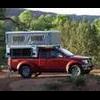I have also replaced my batteries in my 2012 eagle, installed a Victron shunt and Victron 100/12 MPPT, and will install a Li and I am now replacing the Sure Power 1314 Battery Separator as it is clicking and not charging the batteries at all. I purchased the Orion-Tr Smart DC-DC charge, but the isolated model.
Is the Isolated model going to be an issue, or can it be used?
I am not great with electrical vehicle wiring or diagrams but have sketched what I think is my current system and proposed connection to the Orion smart. I will have to confirm the wire gauge, (I think it is 10 gauge). The connection from the vehicle battery to the camper quick connect was installed by FWC Trigard. I also I labeled the thermal breakers as solid state fuses. Oops!
I will follow Jacks post for the installation as close as possible. EDIT: I have labeled Aux. and main battery backwards on the sketches and the existing thermal breakers are 30 amp.
I will also install a cooling fan as suggested by Vic
Wiring the DC-DC From the Truck:
Most recent campers should have similar wiring. I strongly recommend a circuit breaker for you battery such as https://www.amazon.c...e?ie=UTF8&psc=1 . This also acts as a convenient disconnect switch.
- For the Victron, download the VictronConnect App for your phone.
- Replace the 30 A thermal breaker near your truck battery and depending on the wiring to the camper, with a 40 A (10 gauge wire) or 50 A (8 gauge).
- Check the voltage on the “Main Bat” terminal of your battery separator – it should be the truck battery voltage. If not, stop here and troubleshoot or get help. Label the wires connected to the battery separator with tape (“Aux” and “Main”). in case you have to troubleshoot.
- Unplug the camper from the truck or disconnect the positive wire to the camper from the truck battery (or from the auto-reset fuse). Open the circuit breaker or disconnect the wire from positive terminal of the camper battery and tape the end. If you have solar, disconnect the panels. You may be able to unplug the panel(s) on the roof, or disconnect the positive wire from the charge controller and tape the end so it can’t short out accidentally.
- Find a location to mount you DC-DC Charger. Unless the DC-DC has remote voltage sense or adjustable charge voltages, the closer to the battery or the thicker the wire gauge, the better. If you can do the math to adjust the voltages, you can use 10 or even 12 gauge wire with the Victron. NOTE: The Victron can get hot, so make sure it has air flow.
-
(needed to modify this panel)
-
- Disconnect the wire from the “Main Bat” terminal of the battery separator. Connect this wire (or an extension to it) to the input on your DC-DC charger.
- If there are two wires connected to “Aux Bat” post on the battery separator, disconnect them from the battery separator and connect them together. One should go to a 30 A auto-reset fuse – you can leave the fuse in the circuit or remove it. Be sure to tape the connection. If there is only one wire, disconnect and tape it. The Eaton 1341A battery separator has a black wire connected to a spade post. Disconnect it and tape the end.
-
Sorry, forgot to take before pictures.
- Connect the output of the DC-DC Charger to your battery. If the DC-DC is not isolated(most likely), connect the single common ground terminal to the battery. If there are two ground terminals on the DC-DC, connect them together and then to the battery.
- Reconnect the camper to the truck (or connect the camper wire to the truck battery). Verify that you see the truck battery voltage on the input to the DC-DC controller. If not, check your wiring – trace the voltages from the truck to find the problem.
- For the Victron, with the engine running, open the App and set your parameters for battery type and engine running levels. The default Bluetooth pin is 000000. (The Victron website has detailed instructions on setting up and using the App.) You can change the Pin now or later. For a new Pin, choose something easy to remember – like your birth date in 6 digits. Write the Pin on a label and stick it on the controller. Also write the PUK number on the DC-DC Charger on the label as well. The PUK resets the Pin code to 000000.
- If you don’t already have a circuit breaker now is the time to add it. Close the circuit or connect the wire back to the positive terminal of the battery.
- Measure the battery voltage. Start your truck again, and verify that the voltage at the battery is greater. With the Victron, just check your App to verify the DC-DC Charger is charging the battery.
Any suggestions or comments would be appreciated.
Edited by Durabull, 16 July 2021 - 10:07 PM.















